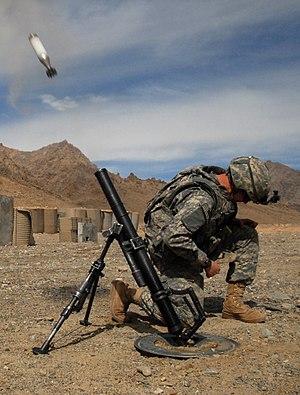

This article needs additional citations for verification. Please help improve this articlebyadding citations to reliable sources. Unsourced material may be challenged and removed.
Find sources: "M224 mortar" – news · newspapers · books · scholar · JSTOR (January 2010) (Learn how and when to remove this message) |
| M224 | |
|---|---|
 | |
| Type | Mortar |
| Place of origin | United States |
| Service history | |
| In service | 1978–present[1] |
| Used by | United States Iraq[2] Ukraine |
| Wars | Vietnam War (prototype model) Gulf War War in Afghanistan Iraq War War in Iraq Russo-Ukrainian War |
| Production history | |
| Unit cost | $10,658 |
| Variants | M224 M224A1 |
| Specifications | |
| Mass | 21.1 kilograms (47 lb) |
| Barrel length | 1 meter (3.3 feet) |
| Crew | 3 |
| Caliber | 60 mm (2.4 in) |
| Rate of fire | up to 20 rpm sustained, 30 rpm in exceptional circumstances and for short periods |
| Effective firing range | HE: 70–3,490 m (76–3,816 yds) |
| Feed system | manual |
The M224 60 mm Lightweight Company Mortar System (LWCMS) is a smoothbore, muzzle-loading, high-angle-of-fire mortar used for close-in support of ground troops. It was deployed extensively in the War in Afghanistan by the United States military.
The M224 system is composed of these parts:
The mount consists of a bipod and a base plate, which is provided with screw-type elevating and traversing mechanisms to elevate/traverse the mortar. The M64A1 sight unit is attached to the bipod mount. The mortar can be fired in the conventional mode or the handheld mode. This smoothbore system can be gravity-fired or fired by using a manual spring-loaded trigger.
It is typically fielded at the infantry company level. A small mortar section with two mortars was organic to Army rifle companies (light, airborne, air assault) and Ranger companies. Marine rifle companies have a section with three 60 mm mortars in the company weapons platoon.
The M224 LWCMS (Lightweight Company Mortar System) replaced the older (WWII-era) 60 mmM2 mortar and the inaccurate M19 Mortar and began fielding as prototypes in the mid-1970s during the Vietnam War. The M2s and M19s had an effective range of only 2,000 m (2,187 yd). While the M224s were designed to fire all types of the older ammunition, their primary rounds are of the newer, longer-range type that range out to 3,489 m (3,816 yd).
In 2011, an improved M224A1 version was brought into service.[3] The M224A1 consists of the M225A1 tube, M170A1 bipod assembly, M7A1 baseplate, M8 auxiliary baseplate and the M64A1 sight unit.[3] By reducing the number of components and using lighter materials, the M224A1 mortar system weighs at about 37.5 lbs (17 kg), which is 20% less with a reduction of 9.3 lb (4 kg) compared to the original M224.[3] The US Army plans to replace all legacy M224s with the new M224A1.[3] Concurrently, a lighter version of the 81 mmM252 mortar was also developed.[citation needed]
The M224 Mortar can fire the following principal classifications of training and service ammunition:
The M224 rounds have three fuze types: The Multioption Fuze (M734), the Point-Detonating Fuze (M525), and Timer fuze. The M734 is used for the M720 HE round and can be set to function as proximity burst, near-surface burst, impact burst, or delay burst.
|
| |||||||||||
|---|---|---|---|---|---|---|---|---|---|---|---|
| Handguns |
| ||||||||||
| Rifles |
| ||||||||||
| Shotguns |
| ||||||||||
| Submachine guns |
| ||||||||||
| Machine guns |
| ||||||||||
| Ordnance |
| ||||||||||
| Cartridges |
| ||||||||||